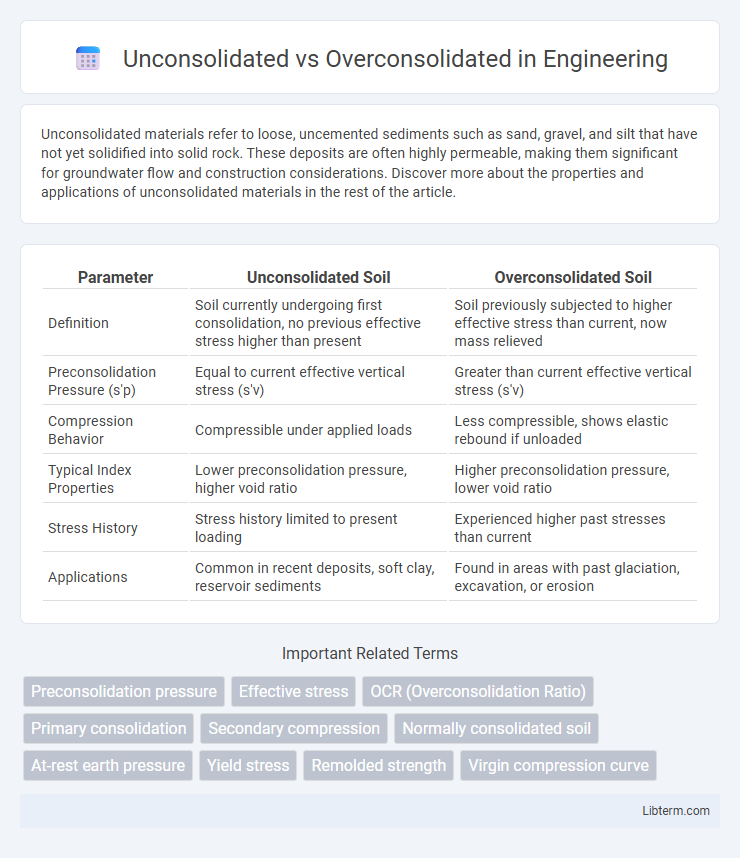Unconsolidated materials refer to loose, uncemented sediments such as sand, gravel, and silt that have not yet solidified into solid rock. These deposits are often highly permeable, making them significant for groundwater flow and construction considerations. Discover more about the properties and applications of unconsolidated materials in the rest of the article.
Table of Comparison
| Parameter | Unconsolidated Soil | Overconsolidated Soil |
|---|---|---|
| Definition | Soil currently undergoing first consolidation, no previous effective stress higher than present | Soil previously subjected to higher effective stress than current, now mass relieved |
| Preconsolidation Pressure (s'p) | Equal to current effective vertical stress (s'v) | Greater than current effective vertical stress (s'v) |
| Compression Behavior | Compressible under applied loads | Less compressible, shows elastic rebound if unloaded |
| Typical Index Properties | Lower preconsolidation pressure, higher void ratio | Higher preconsolidation pressure, lower void ratio |
| Stress History | Stress history limited to present loading | Experienced higher past stresses than current |
| Applications | Common in recent deposits, soft clay, reservoir sediments | Found in areas with past glaciation, excavation, or erosion |
Introduction to Soil Consolidation
Soil consolidation refers to the process by which soil decreases in volume over time due to the expulsion of water from its pores under sustained load. Unconsolidated soils have not experienced significant previous loading, resulting in higher compressibility and greater potential settlement. Overconsolidated soils have been subjected to past pressures exceeding current loads, leading to reduced compressibility and improved shear strength.
Defining Unconsolidated Soils
Unconsolidated soils consist of loose, uncemented particles that have not experienced significant pressure or compaction, often found in river deposits or recent sediments. These soils exhibit high porosity and low shear strength due to their loosely packed grains, making them prone to compression under load. Understanding the properties of unconsolidated soils is crucial for geotechnical engineering, as they differ fundamentally from overconsolidated soils, which have been subjected to previous stress cycles resulting in denser and more stable structures.
Defining Overconsolidated Soils
Overconsolidated soils have previously been subjected to a higher effective stress than their current stress, causing them to exhibit increased strength and reduced compressibility compared to normally consolidated soils. These soils typically form due to past geological processes such as erosion, unloading, or glaciation that reduce stress on the soil layer over time. Understanding the overconsolidation ratio (OCR), which quantifies the extent of past stress, is fundamental in geotechnical engineering for predicting soil behavior under new loading conditions.
Differences in Soil Formation Processes
Unconsolidated soils form through recent sediment deposition without significant compaction, retaining high void ratios and low shear strength, often in riverbeds or floodplains. Overconsolidated soils experience historical loading greater than current stress, leading to denser particle packing and increased strength due to past geological events like glaciation or erosion. These distinct formation processes result in divergent geotechnical properties critical for foundation design and soil stability assessment.
Key Geotechnical Properties Comparison
Unconsolidated soils exhibit low shear strength and high compressibility due to their loosely packed particles and lack of previous consolidation pressure. Overconsolidated soils possess higher shear strength and lower compressibility, reflecting their exposure to past effective stresses greater than the current overburden pressure. Permeability in unconsolidated soils tends to be higher, while overconsolidated soils demonstrate reduced permeability owing to particle rearrangement and swelling effects.
Stress History: Understanding Preconsolidation Pressure
Unconsolidated soils have not experienced effective stress beyond their current stress state, indicating their preconsolidation pressure equals the existing overburden pressure. Overconsolidated soils possess a preconsolidation pressure higher than the present effective stress due to past loading events, reflecting a history of stress exceeding current conditions. Understanding preconsolidation pressure is critical for evaluating soil behavior under loading and predicting settlement and deformation in geotechnical engineering.
Settlement Behavior in Unconsolidated vs Overconsolidated Soils
Unconsolidated soils exhibit higher primary compression and larger total settlements due to their loose structure and lower preconsolidation pressure. Overconsolidated soils show reduced settlement potential with predominantly elastic rebound behavior, resulting from their previously subjected higher stresses. Settlement in overconsolidated soils is often characterized by smaller compression and a higher tendency for immediate settlement under applied loads.
Engineering Implications and Applications
Unconsolidated soils exhibit low strength and high compressibility, leading to increased settlement risks in foundation engineering and requiring careful load management and soil improvement techniques. Overconsolidated soils possess higher shear strength and lower compressibility, making them more stable for structures but often necessitating consideration of anisotropic stress conditions and potential desiccation cracks during construction. Understanding the degree of consolidation is critical for geotechnical designs, slope stability analysis, and predicting long-term soil behavior under various loading scenarios.
Testing Methods for Consolidation State
Testing methods for determining consolidation state include the oedometer test, which applies incremental loading to a soil sample to measure its deformation and identify if it is unconsolidated or overconsolidated. Overconsolidation ratio (OCR) is calculated from test results, with OCR > 1 indicating overconsolidated soils and OCR = 1 indicating normally consolidated (unconsolidated) soils. Interpretation of test curves such as void ratio versus logarithm of effective stress enables characterization of soil behavior under varying stress conditions.
Conclusion: Selecting the Right Soil Type for Projects
Selecting the right soil type between unconsolidated and overconsolidated soils depends on project requirements such as load-bearing capacity, settlement characteristics, and stability needs. Unconsolidated soils, with their loose and less compacted structure, are suitable for projects requiring easier excavation but may pose higher settlement risks. Overconsolidated soils, being denser and preloaded, offer greater strength and stability, making them ideal for supporting heavy structures and minimizing settlement.
Unconsolidated Infographic

 libterm.com
libterm.com